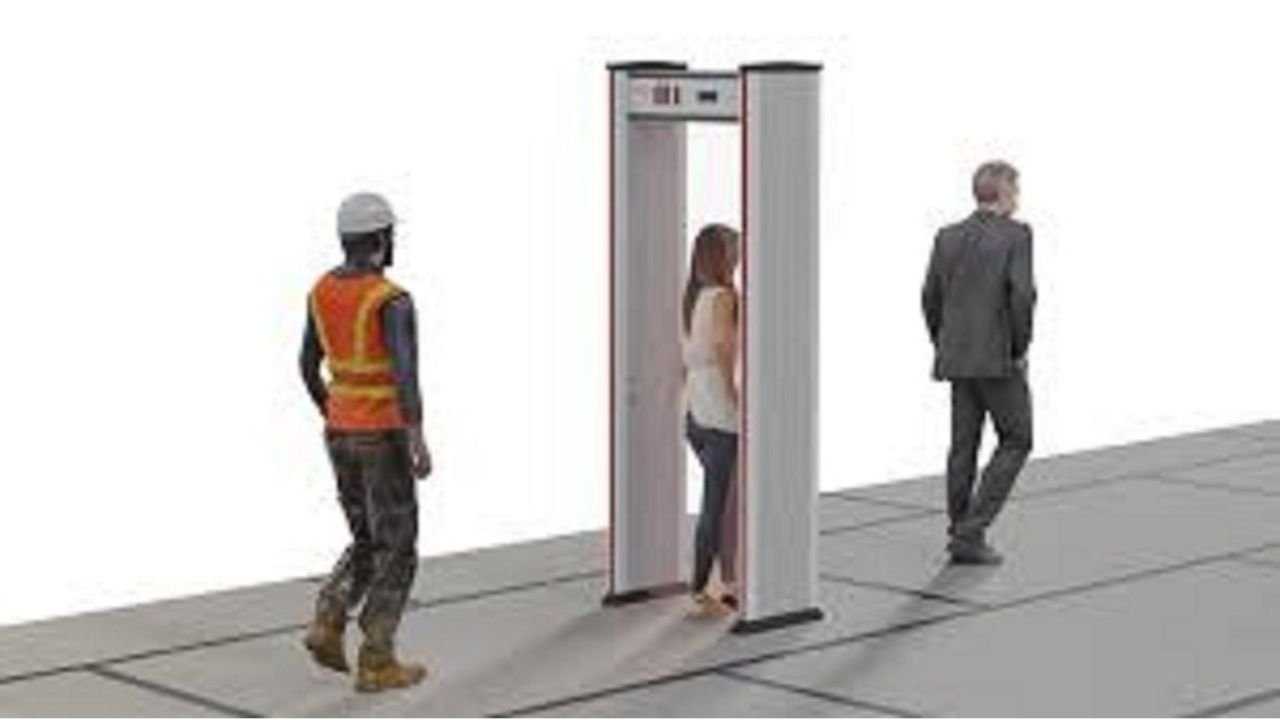In an increasingly security-conscious world, protecting public spaces from potential threats is more critical than ever. Whether it’s an international airport, a crowded shopping mall, or a government office, the need to screen individuals efficiently and non-invasively has driven widespread adoption of reliable security equipment. One of the most commonly used devices in this category is the DFMD, and if you’ve ever walked through a security checkpoint, you’ve likely encountered one. So, what is the DFMD full form? Let’s explore everything there is to know about this important tool.
What is DFMD Full Form?
Full form of DFMD is door frame metal detector. It is a metal detector that is in the form of a door frame that they have to walk through, as the name indicates. It is specially created in order to scan hidden metallic items that might be concealed on the body of an individual. DFMDs are non-contact, which implies that they do not touch and intrude on the personal space, so choosing this low-rank option can be the appropriate decision in the high-traffic security area.
These detectors operate on this principle of electromagnetic induction, where they establish distortions to their electromagnetic field when a metallic object is in contact with it. As an individual passes through the frame with an object that is of a metal type, the device immediately picks it up and sounds out or lights up an alarm that sends the security officers on duty to further examine the walking person.
Understanding DFMD and Its Importance
Security threats have become increasingly sophisticated over time, but so have the tools to counter them. The Door Frame Metal Detector stands as a first line of defense in many security setups. It helps prevent weapons, knives, firearms, and other metallic contraband from entering sensitive areas.
Whether in an airport, courtroom, embassy, or concert venue, the presence of a DFMD ensures a preliminary level of threat detection, reducing the need for constant manual frisking. It is valued for its speed, accuracy, and ease of use, allowing hundreds or even thousands of individuals to be scanned daily without significantly slowing down the flow of foot traffic.
How Does a DFMD Work?
The secret of a DFMD is electromagnetic field technology. The sensor is present in the vertical panels of the structure frame. Such sensors broadcast the electromagnetic waves and observe disturbances. In case when an individual passes through the frame, the detector registers alterations in the magnetic field of any metal embedded on or within the body.
In case a break-in is detected, the DFMD triggers an alarm notification—it may be a beep, flash or even a zone-specific notification in case a certain type of detector is implemented. Noticeably, DFMDs are programmed to make a distinction among various metals, and most contemporary units can be adjusted to respond only to the objects made of metal that are actually related to the threat, thus reducing the rate of false alarms.
Common Use Cases of DFMDs
The DFMD has become a universal tool in numerous industries and sectors. It is most commonly found in:
- Airports: For screening passengers before boarding, ensuring no metallic weapons or prohibited items are carried onboard.
- Government Buildings: Used at courthouses, embassies, and military facilities to maintain a high level of internal security.
- Educational Institutions: Installed in some schools and colleges to ensure a safe environment for students and staff.
- Events and Concerts: Deployed at venues with large crowds to prevent weapons or other dangerous metallic items from being brought in.
- Corporate Offices and Malls: For general crowd control and security screening of employees or visitors.
Advantages of Using DFMDs
The widespread use of DFMDs stems from a variety of benefits they provide in everyday security operations. These advantages include
- Enhanced Security: By detecting concealed metal objects, DFMDs serve as a vital tool for preventing unauthorized and dangerous items from entering secure premises.
- Cost-Effective Implementation: Compared to more advanced scanners like full-body imaging systems or X-ray machines, DFMDs are relatively inexpensive and require minimal upkeep.
- Ease of Use: With a plug-and-play setup and intuitive interface, DFMDs are easy to operate, even for non-technical staff with brief training.
- Efficient Screening: High-traffic areas benefit greatly from DFMDs due to their ability to screen individuals in seconds, without creating bottlenecks.
Limitations of DFMDs
While the DFMD is a powerful tool, it’s not without flaws. It’s important to recognize these limitations to understand where complementary systems are necessary.
- False Alarms: Common items such as coins, belts, or keys may occasionally trigger false alarms, causing unnecessary delays.
- Non-Metallic Threats: DFMDs are ineffective against explosives, plastic weapons, or narcotics unless these are combined with metal components.
- Limited Detection Range: Basic DFMDs may not detect very small or deeply concealed metallic items, especially in crowded conditions.
Pros and Cons of DFMDs
| Advantages | Limitations |
| Enhances public safety | Cannot detect non-metallic objects |
| Cost-effective and low maintenance | May trigger false positives on harmless items |
| Fast and efficient screening | Limited to metallic threat detection |
| Easy to use and install | Needs additional measures for full protection |
Technological Advancements in DFMDs
DFMDs are advancing with the development of technology. The current modern systems are much more endowed than the former. Multi-zone DFMDs enable the security staff to know the specific part of the body in which a metallic item is positioned. This aspect saves time taken to perform manual and pat-downs and it enhances precision in detecting the threat.
Adoption of Artificial Intelligence (AI) is now accompanying some DFMDs, and it creates some sort of reduction in false alerts by considering the size, shape, and density of discovered objects. The mobile DFMDs have also gained great acceptance in temporary security check posts like election centers or game centers, where speed in inspection and movement is essential.
Types of DFMDs
Understanding the DFMD full form also means recognizing its different types, each designed for specific purposes and environments:
- Single-Zone DFMD: This basic model scans the entire frame as one detection zone. It will alert if metal is present but won’t specify the location on the person’s body.
- Multi-Zone DFMD: These detectors are divided into multiple detection zones (6, 18, 33, etc.). They pinpoint exactly where the metallic item is located, making security checks more efficient.
- Portable DFMD: Lightweight and collapsible, these are ideal for mobile security requirements or places where permanent installation isn’t feasible.
- AI-Powered Walk-Through DFMDs: The newest entrants in this field use AI algorithms to detect metal more accurately, filter out harmless items, and even connect with security databases.
DFMDs and Legal Compliance Standards
Security equipment like DFMDs must comply with national and international safety standards. Organizations such as the Bureau of Indian Standards (BIS) or the Federal Communications Commission (FCC) in the US regulate the technical and safety criteria for these devices.
Compliance ensures:
- Safe electromagnetic exposure for individuals.
- Accurate performance metrics.
- Proper use in public and sensitive spaces.
Security agencies are required to test, calibrate, and certify their DFMD systems regularly to maintain compliance and avoid penalties.
Why Knowing the DFMD Full Form Matters
Knowing the acronym of DFMD is not even trivia, but quite on the contrary, it is knowing the mother bone of modern access control systems. This is the reason why this knowledge is important:
Security Professionals
The officers in charge of public safety should realize the functions of DFMDs, their limitations, and the best ways to utilize them. Regardless of the sensitivity level, the use of the multi-zone or single-zone systems, and false alarm troubleshooting, the more familiar you are with the technology, the higher the security control.
In The General Public
Whenever security checks are done, gaining the cooperation of the people will be easier when they know about what DFMDs are and what they do. Something as trivial as taking away metallic items before going into the frame can also greatly decrease wait time and false alarms and make the entire process a breeze for everybody.
Conclusion
To sum it all up, the DFMD full form—Door Frame Metal Detector—represents one of the most essential tools in modern security frameworks. From detecting metallic threats to facilitating crowd control in high-traffic areas, these devices serve as the silent guardians of public safety. While they do have limitations, the evolution of DFMD technology ensures that they remain effective, affordable, and indispensable.
If you are one of the security officers who are involved in large events or plan to attend them, as well as the curious reader who might be interested in safety technologies, you will understand all the features and capabilities they have—you will be able to appreciate all the layers of protection that are quietly working in the background. With serious threats to global security becoming increasingly complex, DFMDs are undoubtedly going to remain tall, both literally and figuratively, as a pillar of the global infrastructure of public safety.
Also read more :- Apple TV Login Tutorial



